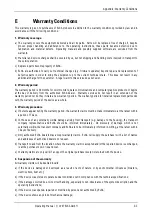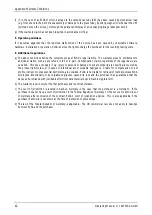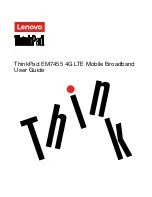
Appendix: Glossary
ELSA TanGo 1000
Operating Manual © 1997 ELSA GmbH
39
I.465
→
V.120
ISDN
Abbreviation of
I
ntegrated
S
ervices
D
igital
N
etwork.
ITU-T
The
T
elecommunications Standardization Sector
of the
I
nternational
T
elecom-
munications
U
nion
(ITU) is working on the standardization of data and telephone
services. The ITU-T standards of the V. series mainly deal with data transmission
across telephone networks, while the I. and Q. series are standards for the ISDN.
The ITU-T is the successor organization of the CCITT
(
C
omité
C
onsultatif
I
nternational
T
élégraphique et
T
éléphonique).
MSN
M
ultiple
S
ubscriber
N
umber.
The
→
DSS1 protocol allows several numbers to be
assigned to one ISDN line by the responsible exchange. Normally these are three
numbers, but may be up to eight. Similar to the
→
EAZ digits of the
→
1TR6
protocol, these numbers can be used to select one of several terminal devices
connected to the same
→
S
0
bus. Unlike the EAZ digit, which is appended to the
actual number, an MSN can be up to eight digits long.
Multiple Subscriber Number
→
MSN
National ISDN-1
→
NI-1
NI-1
The
N
ational
I
SDN-
1
standard is a common specification in the US for the ISDN
→
D
channel protocol.
NT
N
etwork
T
erminator.
This is a device installed on the terminal side of an ISDN
→
Basic Rate Interface which converts the signals coming from the exchange into the
form needed by the
→
S
0
interface, and vice versa.
Parity bit
The parity bit is a control bit that is sent in addition to a number of data bits in a
data transmission. The data bits set to "1" are supplemented by the parity bit to an
even or odd bit sum. The parity check is a simple method of error detection.
However, this method is not very reliable, as for example double bit errors are not
recognized. Therefore in data communications normally "no parity" is selected,
which besides results in an increase of the transmission speed, since no additional
parity bit has to be sent.
S
0
bus
Link between
→
Basic Rate Interface and terminal device. Up to eight ISDN terminal
devices can be operated simultaneously on one S
0
bus, and up to 12 connection
sockets can be connected to the bus.
Synchronous
Synchronous transmission
is, like
→
asynchronous transmission, a method to
transmission
synchronize transmitter and receiver. Unlike asynchronous
transmission, in this method of data transmission the synchronization is not
achieved by start and stop bits for an entire character, but by clock pulses for each
single bit. Due to the elimination of the additional start and stop bits, synchronous
transmission is faster, but also requires a considerably greater technical effort.
T.70NL
T.70NL is a data packet header used in the transmission standard
→
X.75. The
T.70NL header must be enabled or disabled on both ends of the transmission.
TA
→
Terminal adapter
Содержание TanGo 1000
Страница 1: ...ELSA TanGo 1000 User Manual ...
Страница 6: ...Table of Contents 4 ELSA TanGo 1000 Operating Manual 1997 ELSA GmbH ...
Страница 10: ...Introduction 8 ELSA TanGo 1000 Operating Manual 1997 ELSA GmbH Notes ...
Страница 22: ...Software Installation 20 ELSA TanGo 1000 Operating Manual 1997 ELSA GmbH Notes ...
Страница 28: ...Frequently Asked Questions and Answers 26 ELSA TanGo 1000 Operating Manual 1997 ELSA GmbH Notes ...






































